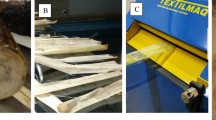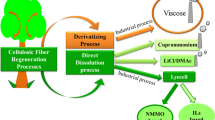Abstract
A new approach to prepare cellulose nanofiber was attempted using the combined method of hot-compressed water (HCW) treatment and disk milling. The HCW treatment was effective in loosening the cell wall structure and enhancing fibrillation by disk milling. The fibrillated products showed fine fibrous morphology at the nanometer scale. Filtration time and specific surface area were measured as criteria of the degree of fibrillation, and both these values were increased in nanofibers obtained by disk milling after HCW treatment. The obtained nanofiber-reinforced polyurethane composite was prepared, and its tensile properties were drastically improved by the increased nanofiber content.






Similar content being viewed by others

References
Abe K, Iwamoto S, Yano H (2007) Obtaining cellulose nanofibers with a uniform width of 15 nm from wood. Biomacromolecules 8:3276–3278
Ando H, Sakaki T, Kokusho T, Shibata M, Uemura Y, Hatate Y (2000) Decomposition behavior of plant biomass in hot-compressed water. Ind Eng Chem Res 39:3688–3693
Awano T, Takabe K, Fujita M, Daniel G (2000) Deposition of glucuronoxylans on the secondary cell wall of Japanese beech as observed by immuno-scanning electron microscopy. Protoplasma 212:72–79
Azeredo HMC, Mattoso LHC, Wood D, Williams TG, Avena-Bustillos RJ, McHugh TH (2009) Nanocomposite edible films from mango puree reinforced with cellulose nanofibers. J Food Sci 74(5):31–35
Bhatnagar A, Sain M (2005) Processing of cellulose nanofiber-reinforced composites. J Reinf Plast Compos 24(12):1259–1268
Cao X, Chen Y, Chang PR, Muir AD, Falk G (2000) Starch-based nanocomposites reinforced with flax cellulose nanocrystals. Polym Lett 2(7):502–510
Chakraborty A, Sain M, Kortschot M (2005) Cellulose micriofibrils: a novel method of preparation using high shear refining and cryocrushing. Holzforschung 59:102–107
Chen G, Liu H (2008) Electrospun cellulose nanofiber reinforced soybean protein isolate composite film. J Appl Polym Sci 110:641–646
Cheng Q, Wang S, Rials TG, Lee SH (2007) Physical and mechanical properties of polyvinyl alcohol and polypropylene composite materials reinforced with fibril aggregates isolated from regenerated cellulose fibers. Cellulose 14(6):593–602
Dufresne A, Cavaille JY, Vignon MR (1997) Mechanical behavior of sheets prepared from sugar beet cellulose microfibrils. J Appl Polym Sci 64(6):1185–1194
Eichhorn SJ, Dufresne A, Aranguren M, Marcovich NE, Capadona JR, Rowan SJ, Weder C, Thielemans W, Roman M, Renneckar S, Gindl W, Veigel S, Keckes J, Yano H, Abe K, Nogi M, Nakagaito N, Mangalam A, Simonsen J, Benight AS, Bismarck A, Berglund LA, Peijs T (2010) Review: current international research into cellulose nanofibres and nanocomposites. J Mater Sci 45:1–33
Gindl W, Keckes J (2005) All-cellulose nanocomposite. Polymer 14:10221–10225
Hajji P, Cavaillé JY, Favier V, Gauthier C, Vigier G (2004) Tensile behavior of nanocomposites from latex and cellulose whiskers. Polym Composit 17(4):612–619
Henriksson M, Berglund LA (2007) Structure and properties of cellulose nanocomposite films containing melamine formaldehyde. J Appl Polym Sci 106:2817–2824
Iwamoto S, Nakagaito AN, Yano H (2005) Optically transparent composites reinforced with plant fiber-based nanofibers. Appl Phys A Mater Sci Process 81(6):1112
Iwamoto S, Abe K, Yano H (2008) The effect of hemicelluloses on wood pulp nanofibrillation and nanofiber network characteristics. Biomacromolecules 9:1022–1026
Japanese Wood Research Society (2000) Experimental manual for wood science. Bun-eido Publishing Co., Ltd, Japan, p 94
Jonoobi M, Harun J, Mathew AP, Hussein MZP, Oksman K (2010) Preparation of cellulose nanofibers with hydrophobic surface characteristics. Cellulose 17:299–307
Kaida R, Kaku T, Baba K, Oyadomari M, Watanabe T, Nishida K, Kanaya T, Shani Z, Shoseyov O, Hayashi T (2009) Loosening xyloglucan accelerates the enzymatic degradation of cellulose in wood. Molecul Plant 2(5):904–909
Lee SH, Teramoto Y, Endo T (2009) Enhancement of enzymatic accessibility by fibrillation of woody biomass using batch-type kneader with twin-screw elements. Bioresour Technol 101:769–774
Lee SH, Chang F, Inoue S, Endo T (2010) Increase in enzyme accessibility by generation of nanospace in cell wall supramolecular structure. Bioresources Technol 101:7218–7223
Maiti P, Yamada K, Okamoto M, Ueda K, Okamoto K (2002) New polylactide/layered silicate nanocomposites: role of organoclays. Chem Mater 14:4654–4661
Nakagaito AN, Yano H (2004) The effect of morphological changes from pulp fiber towards nano-scale fibrillated cellulose on the mechanical properties of high-strength plant fiber based composites. Appl Phys A Mater Sci Process 80:547–552
Nakagaito AN, Iwamoto S, Yano H (2005) Bacterial cellulose: the ultimate nano-scalar cellulose morphology for the production of high-strength composite. Appl Phys A Mater Sci Process 80:93–97
Nishino T, Takano K, Nakamae K (2003) Elastic modulus of the crystalline regions of cellulose polymorphs. J Polym Sci Part B Polym Phys 33(11):1647–1651
Nogi M, Iwamoto A, Nakagaito AN, Yano H (2009) Optically transparent nanofiber paper. Adv Mater 20:1–4
Oksman K, Sain M (2006) Cellulose nanocmposites; processing, characterization and properties. ACS symposium series vol. 938. Oxford University Press, Oxford
Ougiya H, Hioki N, Watanabe K, Morinaga Y, Yoshinaga F, Samejima M (1998) Relationship between the physical properties and surface area of cellulose derived from adsorbates of varous molecular sizes. Biosci Biotechnol Biochem 62:1880–1884
Ray SS, Okamoto M (2003) Polymer/layered silicate nanocomposites: a review from preparation to processing. Prog Polym Sci 28:1539–1641
Saito T, Kimura S, Nishiyama Y, Isogai A (2007) Cellulose nanofibers prepared by TEMPO-mediated oxidation of native cellulose. Biomacromolecules 8:2485–2491
Sakaki T, Shibata M, Miki T, Hirosue H, Hayashi N (1996) Reaction model of cellulose decomposition in near-critical water and fermentation of products. Bioresour Technol 58:197–202
Samir MASA, Alloin F, Sanchez JY, Dufresne A (2004) Cross-linked nanocomposite polymer electrolytes reinforced with cellulose whiskers. Macromolecules 37:4839–4844
Samir MASA, Alloin F, Dufresne A (2005) Review of recent research into cellulosic whiskers, their properties and their application in nanocomposite field. Biomacromolecules 6:612–626
Schopfer P (2006) Biomechanics of plant growth. Am J Bot 93:1415–1425
Stelte W, Sanadi AR (2009) Preparation and characterization of cellulose nanofibers from two commercial hardwood and softwood pulps. Ind Eng Chem Res 48:11211–11219
Tang C, Liu H (2008) Cellulose nanofiber reinforced poly (vinyl alcohol) composite film with high visible light transmittance. Compos Part A Appl Sci Manuf 39(10):1638–1643
Taniguchi T, Okamura K (1998) New films produced from microfibrillated natural fibres. Polym Int 47(3):291–294
Wan JQ, Wang Y, Xiao Q (2010) Effects of hemicellulose removal on cellulose fiber structure and recycling characteristics of eucalyptus pulp. Bioresour Technol 101:4577–4583
Wu Q, Henriksson M, Liu X, Berglund LA (2007) A high strength nanocomposite based on microcrystalline cellulose and polyurethane. Biomacromolecules 8(12):3688–3692
Yano H, Sugiyama J, Nakagaito AN, Nogi M, Matsuura T, Hikita M, Handa K (2005) Optically transparent composites reinforced with networks of bacterial nanofibers. Adv Mater 17(2):153–155
Author information
Authors and Affiliations
Corresponding author
Rights and permissions
About this article
Cite this article
Chang, F., Lee, SH., Toba, K. et al. Bamboo nanofiber preparation by HCW and grinding treatment and its application for nanocomposite. Wood Sci Technol 46, 393–403 (2012). https://doi.org/10.1007/s00226-011-0416-0
Received:
Published:
Issue Date:
DOI: https://doi.org/10.1007/s00226-011-0416-0



